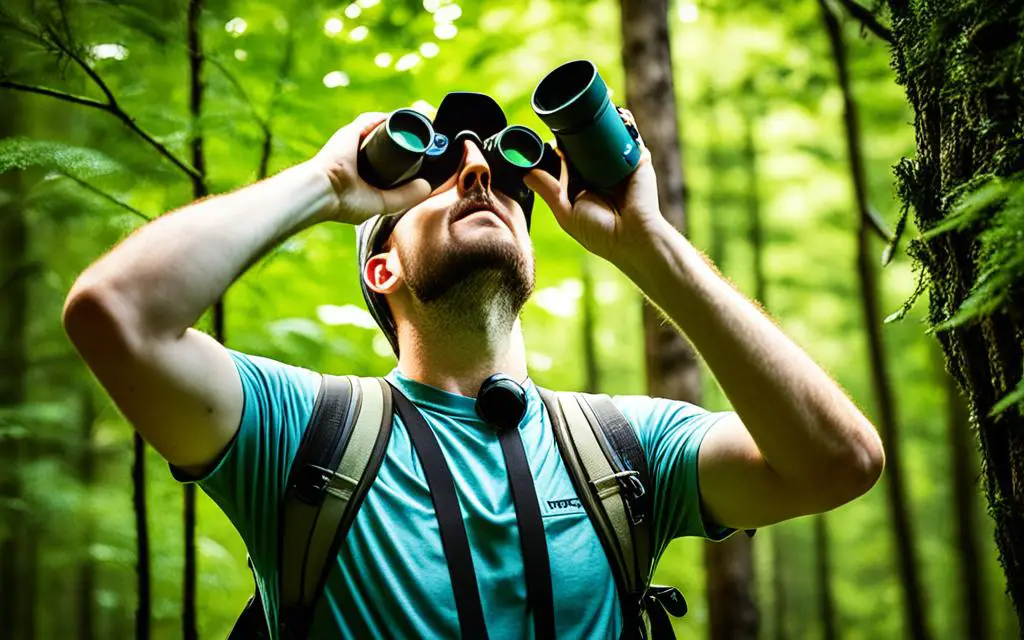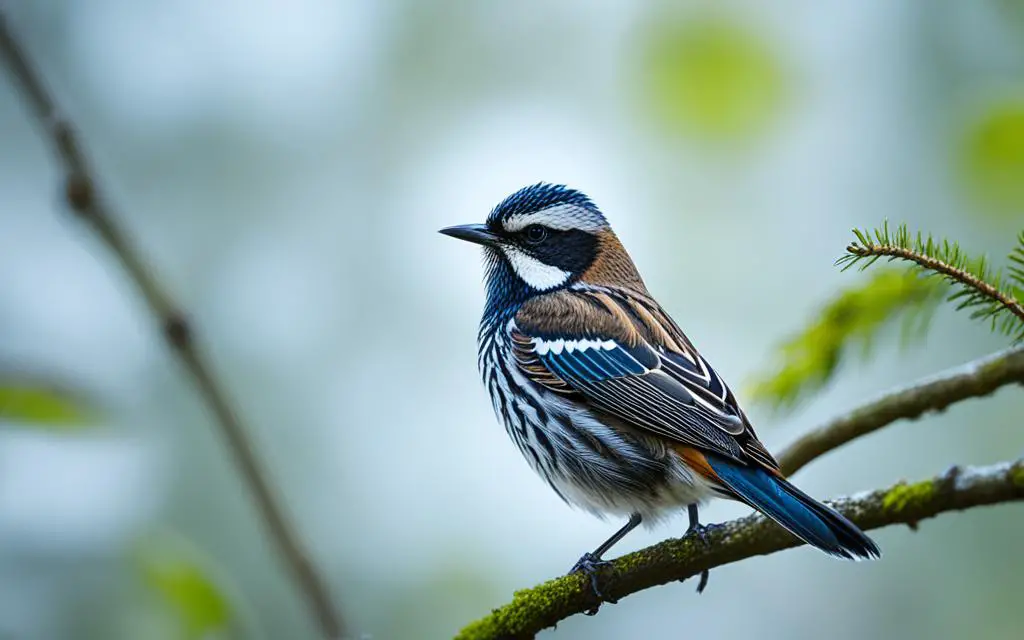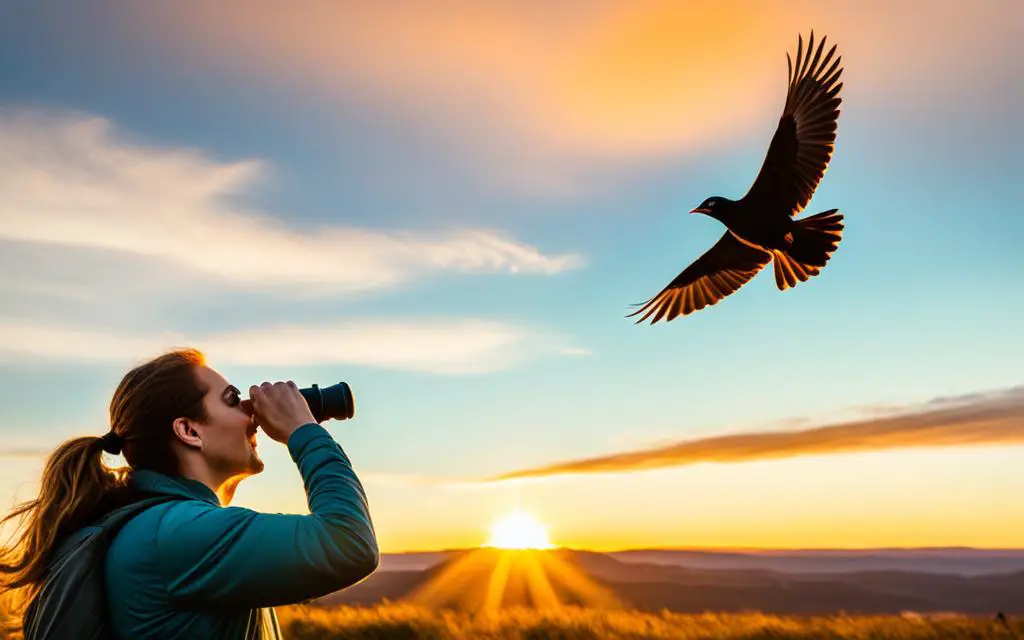Did you know a birdwatcher can know over 100 bird calls just by hearing them? Birdwatching with sight and sound makes it way cooler. It makes you keenly aware of the birds and nature around you. By bettering your seeing and hearing, birdwatching becomes a real adventure.
Birdwatching is more than just looking. It’s feeling the world around you with all your senses. Sharpening your senses lets you see the small, cool stuff birds do. Mindful birding means we connect deeply with nature, making our lives richer.
Key Takeaways
- Birdwatching gets better when we use our eyes and ears.
- Knowing bird behavior makes birdwatching more fun.
- It’s key to be aware of the outdoors to watch birds well.
- Mindful birding brings us closer to nature.
- To see and hear birds better, we need patience and practice.
The Importance of Mindfulness in Birdwatching
Mindfulness in birdwatching makes us better at seeing nature and feeling closer to it. By paying attention and focusing, we get better at noticing and enjoying birds.

Heightening Physical Sensations
I start by sitting still and comfortably. This helps me pay attention to my breathing and what I feel around me. These sensations make me more aware of my surroundings, making birdwatching more rewarding.
Practicing Auditory Focus
Listening carefully is key in mindful birding. By focusing on sounds, I can tell different birds apart. This not only improves my listening but also helps me find birds I can’t see.
Enhancing Visual Acuity
To see better, I look closely at both the big scene and small details. Paying attention to visual clues helps me find birds easier. This skill is important for anyone wanting to watch birds better.
Tools and Techniques for Better Bird Observation
Starting birdwatching is rewarding with the right tools and techniques. Always carry bird field guides. They are key for identifying different bird species. Honing your birding skills is a journey. The more you learn about species, the better you become at spotting birds.
For sight birding, top-quality optics are key. This includes binoculars or a spotting scope. Knowing camera settings and lenses helps too. When you adjust your camera right, you capture birds’ details from afar. This makes your observation more fulfilling.
To excel in birding, mix tools with skill-building techniques. Learning to use bird field guides well is vital. It helps you understand species, behaviors, and habitats better. This knowledge and skill set boosts your bird noticing and documenting ability.
| Tool | Benefit | Usage Tip |
|---|---|---|
| Binoculars | Clear, magnified view of birds at a distance | Choose binoculars with a wide field of view for easier spotting |
| Bird Field Guides | Essential for identifying and learning about species | Cross-reference with online databases for the latest information |
| Camera with Telephoto Lens | Captures detailed images of birds from afar | Use a tripod to reduce camera shake and get sharper images |
| Spotting Scope | Enhanced magnification for distant birds | Great for waterfowl and shorebird observation |
Using these birdwatching tools and techniques improves your skills. They make birding more fun for everyone, from beginners to experts. Practice is essential for sharpening your senses. It helps you become great at spotting birds in their natural surroundings.
Using Your Senses to Identify Bird Calls
Learning to identify bird calls makes birdwatching much more fun. It opens up a new world of discovery. By listening and recognizing different bird songs, you can find birds that stay hidden.

Common Bird Calls to Recognize
Start with familiar bird calls to build your base. Listen to the American Robin’s songs or the Northern Cardinal’s chirps. This way, you can know birds by their sounds, even if you can’t see them.
Differentiating Between Similar Sounds
Telling similar bird calls apart can be tough. Differences in pitch, rhythm, and how often they repeat matter. With careful listening and lots of practice, you’ll notice the small differences. This will help you identify birds and feel closer to nature.
Sharpen Your Senses: Tips for Observing Birds Through Sight and Sound
Starting to bird watch can be fun and learning. Notice things like bird colors, what they do, and where they live. This helps you know which bird is which. Using your eyes and ears makes birding special and connects you with nature.

Paying Attention to Small Details
It’s important to see small things when you’re new to birding. Once, I spotted an American Robin’s eye-ring. These small things are key to knowing your birds. Watching birds move and live gives you hints about who they are. Every little detail matters.
Using Both Sight and Sound for Identification
Seeing and hearing birds adds to your bird watching. Seeing a bird’s feathers and hearing its song completes its picture. Sounds help find and know birds, even if it’s hard to see them. Learning to look and listen well improves your birding skills. It makes your adventure in birding much better.
The Role of Patience and Quiet Observation
Patience and quiet observation are key in birdwatching. By sitting still and listening, I’ve found amazing things in nature. Birds show up in unexpected and wonderful ways when we’re calm and quiet around them.
This way of watching birds deepens our connection with nature. It makes every birding experience better.
This method isn’t only for expert birdwatchers. Teaching kids to watch and listen carefully can change how they learn outdoors. Even simple trips outdoors can teach them a lot. They start to see the small things in bird behavior and love nature more.
Mindful birdwatching is all about quiet watching and living in the now. It’s more than just seeing or hearing. It’s about feeling part of nature. By being patient and attentive, birdwatching is more fun. It makes me love nature’s beauty even more.
Source Links
- https://www.mindful.org/a-meditation-for-exploring-your-senses/
- https://photzy.com/bird-photography-stay-sharp-and-focused/
- https://www.allaboutbirds.org/news/find-more-birds-with-these-8-suggestions-for-your-birding-routine/

My name is Shane Warren, the author behind Your Bird Buddy – your ultimate guide to the wonderful world of birds! Unleash your inner avian explorer as we delve into a vibrant library of knowledge dedicated to all things feathered. From learning about diverse bird species from across the globe to understanding their captivating habitats and behaviors, I’m here to fuel your passion for these magnificent creatures. Not only that, but I also provide valuable insights on being a responsible and informed pet bird owner. Join our vibrant community and let’s celebrate the feathered wonders of the world together – one chirp at a time. And be sure to join our Your Bird Buddy Community over on Facebook!


Comments are closed